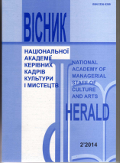"MUGHAM" – CULTURAL AND SPIRITUAL MIRROR ETHNOGENETIC PROCESSES AZERBAIJANI HISTORY
DOI:
https://doi.org/10.32461/2226-3209.2.2014.137991Keywords:
mugam, ethnicity, culture, Azerbaijan identityAbstract
Undoubtedly, mugham, which is the spiritual heritage of the majority of the eastern nations, in the treasury of the Azerbaijani culture has a special and most prominent due to the fact that this genre reflects the individual periods of formation of development of national consciousness. Rhythms, and the names themselves mugams allow to draw a map of ethnogeographical area where there was a process of formation of Azerbaijani culture.
Tremendous value, which represents the mugham, has always been in many nations of the East, especially the Persians, the desire to present it to the world as a national genre, which is based purely Persian musical motifs. Iranian authors' claims of Iranian origin mugham not find much support among historians and musicologists. Systematic study showed that the origin of mugham its roots in ancientIndia, in the folklore of the ancient Arabs and Turks. Mugam in turn is the genre that brings spiritual peace and a positive mood because of its initial purpose. This nuance has left its traces in the form of classical mugham performance. After mugham that runs entirely consists of different topics, which together form one harmonious melody, that is – "desgah". Separate sections of mugham associated with the presence of human life stages. That is, first performed more fun pace that symbolizes youth , later becoming a slower pace and serious, indicating adulthood. Next executed sad music that makes a person think . These rates hint at an older age. By the end of the rate of re-amplified, that displays death and rebirth, which according to ancient Indian beliefs are happiness and liberation from the perishable world. Speaking about the development of mugham , we must not forget the contribution made by the Turks and Kurds in the formation of national Azerbaijani mugam. Without going into the details enough to remember names such as the mugham "Kurd ovshary", "Bayati – Kurd", "Bayati – Turk" etc.
Their emergence and development are inextricably linked with the name of these people, whose psychology is reflected in the dynamics of the performance of these mugam. I wonder what musical genres associated with the name of The Kurds and the musical culture of the neighboring couThe question of continuity with mugham ethnic psychology and founder of Classical affected Azerbaijani music U. Hajibayli "There mugams that inspire a person peace of mind. These include mugams as "Isfahan", "Irag" etc. They prefer to listen to the Persians, and conversely there are mugams as "Neva", "Ushshak" listeners who are Turks. These differ in their mugams dynamics and positive emotions. "Azerbaijani mugham school so successfully rallied those differences together and create a single body that today Azerbaijani performers listening very difficult to determine their Persian and Turkic beginning.
The same "Mahur", which was mentioned above, because the richest traditions of Azerbaijani culture in spite of his Indian roots reached its perfect form in the interpretation of the Azerbaijani Mugam school. It is no coincidence that it was the name of Azerbaijani performers inextricably related to the emergence of independent form Machura – Orta Mahur ("Average Mahur"). In contrast, from the "Mahur – Hindi" "Orta Mahur" riddled with violent spirit that not only inspires positive emotions, but also calls for courage. Because of the latter factor, "Orta Mahur" abounds huge amount of grace (zengyule), and requires the performance of the highest vocal technique. For this reason, not every professional performer finds the courage to take up the performance of "Orta Mahurntries, especiallyTurkeyandIran.
Downloads
Published
Issue
Section
License
Authors who publish with this journal agree to the following terms:
1. Authors retain copyright and grant the journal right of first publication with the work simultaneously licensed under a Creative Commons Attribution License that allows others to share the work with an acknowledgement of the work's authorship and initial publication in this journal.
2. Authors are able to enter into separate, additional contractual arrangements for the non-exclusive distribution of the journal's published version of the work (e.g., post it to an institutional repository or publish it in a book), with an acknowledgement of its initial publication in this journal.
3. Authors are permitted and encouraged to post their work online (e.g., in institutional repositories or on their website) prior to and during the submission process, as it can lead to productive exchanges, as well as earlier and greater citation of published work (See The Effect of Open Access).


